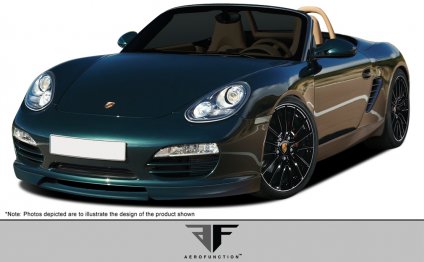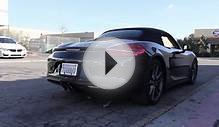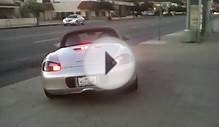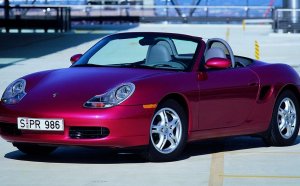
2001 Porsche Boxster Body Kits
The Porsche® 911® GT2, the ultimate Porsche design for 2002, is 10-percent more powerful and seven-percent lighter compared to 911 Turbo which its based. The greatest fat savings across 911 Turbo arises from making the GT2 rear-wheel drive (the 911 Turbo is all-wheel drive). Various other weight-saving actions consist of installing sport seats in front and deleting the rear seating. As opposed to a spare tire, there's a tire repair system. Chassis modifications come straight from Porsches road racing experience. The GT2 can speed up from zero-to-62 miles per hour (zero-to-100 km/h) in about four seconds and will achieve a high track speed of 195 mph (315 km/h).
an altered type of the 3.6-liter twin-turbo six-cylinder boxer motor through the 911 Turbo permits an increase in maximum turbo boost stress to 14.5 psi, when compared with 11.76 psi for the 911 Turbo. The GT2 engine creates 456 horse power at 5, 700 rpm and sustains 457 lb.-ft. (620 Nm) of peak torque from 3, 500-4, 500 rpm. The only real transmission offered is a modified form of the 911 Turbo six-speed handbook. An unique asymmetric limited-slip differential helps support the automobile in curves under load modifications.
When compared to 911 Turbo, redesigned air intake scoops provide additional air conditioning environment. Porsche refined the aerodynamic attributes to create higher downforce. A one-piece fixed-design back wing replaces the two-piece automatic-deploying spoiler for the 911 Turbo and permits 1-6 levels adjustment for racetrack driving. Suspension system changes include racing springs that lower the center of gravity by 0.78-inch (20 mm), adjustable anti-roll bars and many suspension modification to support racing tires. Leading alloy tires measure 18 x 8.5-inch and mount 235/40 ZR18 tires. The trunk alloy rims measure 18 x 12-inch and attach 315/30 ZR18 tires.
The 911 GT2 may be the very first Porsche becoming fitted as standard with all the Porsche Ceramic Composite Brake (PCCBTM). The porcelain composite discs weigh 50-percent under similar metal discs, lowering unsprung fat by an important 36.6 lb. (16.6 kg) and therefore enhancing suspension system reaction.
The GT2 maintains all present Porsche security technology, including double front side airbags in addition to the Porsche Side Impact coverage program, including boron-steel door reinforcement beams, energy-absorbing home panels and door-mounted side airbags. The 30-liter ability sidebags offer additional defense when it comes to chest, mind, and pelvis.
Although the 911 GT2 deletes a number of the luxury content from the 911 Turbo, its standard gear includes power house windows and an anti-theft system with transponder secret, immobiliser, alarm plus main locking with remote entry. The GT2 substitutes a CD audio system for Bose electronic speakers found in the 2002 911 Turbo. Automatic climate control and cruise control and normal leather trim are available as choices.
The 2002 Carrera 4S combines the 3.6-liter, 320-horsepower generally aspirated 911 Carrera motor using all-wheel drive chassis, human anatomy design and have content regarding the 911 Turbo. The 911 Carrera 4S replaces the 911 Carrera 4 Coupe into the Porsche line.
The Carrera 4S stocks the 911 Turbos standard human anatomy shell but adds unique design elements. Rather than the Turbos two-piece back spoiler, the Carrera 4S keeps the automatic-deploying rear spoiler applied to other 911 Carrera designs. From back, the quick tip-off into the models identification is its unique reflector strip connecting the taillights. The Carrera 4S deletes the Turbos big intake ducts ahead of the rear tires, because these are just required on the Turbo to produce environment towards the turbo intercoolers. The 911 Carrera 4S does retain the Turbos lower rear one-fourth panel louvers.
The 2002 911 Targa changes a sliding glass roofing design very first utilized on the previous-generation 911 Targa, offered in the U.S. in 1996 and 1997. The all-new 911 Targa stocks this new 3.6-liter, 320-horsepower engine, 911 Turbo-inspired front-end styling and interior enhancements using the redesigned 911 Carrera models that Porsche launched for 2002. The brand new motor tends to make these the essential powerful ordinarily aspirated 911 models ever before offered in the united states. In profile, the 911 Targa is distinguished by its sharply tapered rear part cup.
The brand new Targa expands on notion of the last design, which launched a large power-operated sliding glass roof that slid under the back window. The largest difference from the previous 911 Carrera Targa is the fact that back window inside new-model is hinged to open up, providing convenient usage of the rear luggage storage space.
Porsche features somewhat enhanced the 911 Carrera models for 2002, their fourth model 12 months, providing them with a bigger, stronger engine and a brand new look inspired because of the 911 Turbo. The range includes the 911 Carrera Coupe and Cabriolet and also the all-wheel drive 911 Carrera 4 Cabriolet. A fresh type of the 911 Carrera 4 Coupe will likely be introduced later on when you look at the model year. While maintaining their unmistakable 911 profile, the 2002 models follow the headlight design for the 911 Turbo, plus a newly formed forward end, widened rear one-fourth panels, and redesigned oval exhaust tailpipes.
All designs benefit from a strengthened body structure, which enhances dealing with, ride high quality and security. The style changes benefit performance, increasing airflow toward radiators by 15 % and lowering aerodynamic lift on the front and rear suspension system. The Bi-Xenon gas-discharge headlights which can be standard on 911 Turbo are a option for the 911 Carrera designs.
Porsche enlarged the displacement associated with six-cylinder boxer motor within the 911 Carrera designs to 3.6 liters from 3.4 liters and increased horse power to 320 from 300. Peak torque increases to 273 lb.-ft. at 4, 250 rpm from 258 lb.-ft. at 4, 600 rpm, plus the torque curve is wider in general for enhanced reaction after all speeds. The newest VarioCam® Plus valve time and lift system just like which used regarding the 911 Turbo assists improve torque. Porsche optimized suspension system tuning for enhanced performance, and new-design Carrera II 17-inch alloy rims minimize unsprung weight.
The 911 Carrera 4 Cabriolet all-wheel drive system utilizes a viscous multi-plate clutch mounted only behind the leading differential. The Cabriolet features a fully automated power roofing, an automatic deploying supplemental safety club structure, and a regular removable aluminum hardtop. A glass rear screen with fundamental defroster replaces the polycarbonate screen when you look at the Cabriolet. Safety technology includes a patented crumple-zone physiology, double front side airbags, door-mounted side airbags...
INTERESTING VIDEO



Share this Post
Related posts
2001 Porsche Boxster Owners Manual
Publications & Technical Documentation - webpage 1 By Wayne R. Dempsey. Maybe you have desired to do your maintenance…
Read More2014 Porsche Boxster S Review
Completely revised for just last year, the Porsche Boxster continues to the 2014 model year unchanged, regardless of a set…
Read More










